

If you get the above output, then it means that your CPU supports virtualization and you can setup a KVM virtualization host thereon.
 Operating System - Rocky Linux release 9.0 (Blue Onyx)Ĭonnect with as root user by using a ssh client.īy executing lscpu command, you can easily verify that, Is your CPU is supporting virtualization or not? # lscpu | grep Virtualization. We are using a Rocky Linux 9 minimal installed virtual machine with following specifications. Recommended Online Training: Linux KVM for System Engineers Recommeded Book: Mastering KVM Virtualization by Vedran Dakic, Humble Devassy Chirammal & 2 more Every VM is implemented as a regular Linux process, scheduled by the standard Linux scheduler, with dedicated virtual hardware like a network card, graphics adapter, CPU(s), memory, and disks. KVM has all these components because it’s part of the Linux kernel. All hypervisors need some operating system-level components-such as a memory manager, process scheduler, input/output (I/O) stack, device drivers, security manager, a network stack, and more-to run VMs. KVM converts Linux into a type-1 (bare-metal) hypervisor. Because KVM is part of existing Linux code, it immediately benefits from every new Linux feature, fix, and advancement without additional engineering.
Operating System - Rocky Linux release 9.0 (Blue Onyx)Ĭonnect with as root user by using a ssh client.īy executing lscpu command, you can easily verify that, Is your CPU is supporting virtualization or not? # lscpu | grep Virtualization. We are using a Rocky Linux 9 minimal installed virtual machine with following specifications. Recommended Online Training: Linux KVM for System Engineers Recommeded Book: Mastering KVM Virtualization by Vedran Dakic, Humble Devassy Chirammal & 2 more Every VM is implemented as a regular Linux process, scheduled by the standard Linux scheduler, with dedicated virtual hardware like a network card, graphics adapter, CPU(s), memory, and disks. KVM has all these components because it’s part of the Linux kernel. All hypervisors need some operating system-level components-such as a memory manager, process scheduler, input/output (I/O) stack, device drivers, security manager, a network stack, and more-to run VMs. KVM converts Linux into a type-1 (bare-metal) hypervisor. Because KVM is part of existing Linux code, it immediately benefits from every new Linux feature, fix, and advancement without additional engineering. 
KVM was first announced in 2006 and merged into the mainline Linux kernel version a year later. If you’ve got Linux 2.6.20 or newer, you’ve got Linux hypervisor. Specifically, KVM lets you turn Linux into a hypervisor that allows a host machine to run multiple, isolated virtual environments called guests or virtual machines (VMs). Kernel-based Virtual Machine (KVM) is an open source virtualization technology built into Linux®.
 Install Cockpit Web UI on Rocky Linux 9. In this tutorial, you will learn how to setup KVM virtualization host on Rocky Linux 9 or other RPM based Linux distros.
Install Cockpit Web UI on Rocky Linux 9. In this tutorial, you will learn how to setup KVM virtualization host on Rocky Linux 9 or other RPM based Linux distros.








 0 kommentar(er)
0 kommentar(er)
